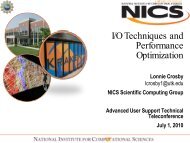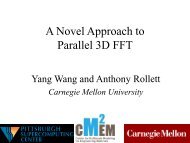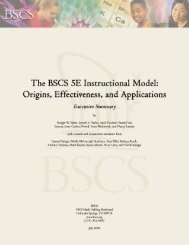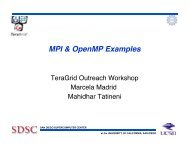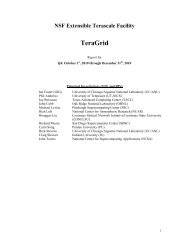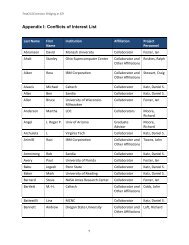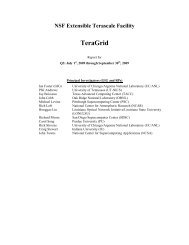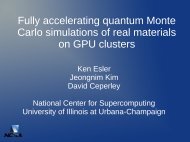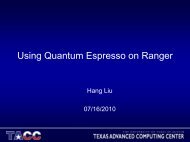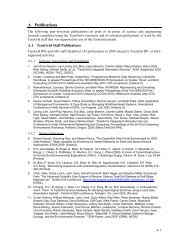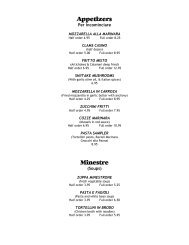TGQR 2010Q2 Report.pdf - Teragridforum.org
TGQR 2010Q2 Report.pdf - Teragridforum.org
TGQR 2010Q2 Report.pdf - Teragridforum.org
Create successful ePaper yourself
Turn your PDF publications into a flip-book with our unique Google optimized e-Paper software.
demonstrate collaborations with other grids, across several domains, or with international<br />
partners.<br />
The TRAC Deadline Announcement is disseminated by Leake each quarter about two weeks<br />
prior to the deadline. The announcement is published in HPCWire, iSGTW, Supercomputing<br />
Online, and other relevant external media, as well as TeraGrid User News and the TG.<strong>org</strong> news<br />
site. We typically wait until we have the statistics from the previous cycle, and include those in<br />
the announcement. Therefore, it serves a dual purpose—deadline announcement and summary of<br />
the previous cycle’s applications and awards. Although TeraGrid’s allocation process is<br />
becoming progressively more oversubscribed, we have been increasing efforts to push this<br />
announcement in hopes of engaging a broader user base with TeraGrid resources. The increased<br />
competitive element could result in more creative uses of TeraGrid resources, better justification<br />
of resources, and better allocation applications overall.<br />
Misc. External Relations Working Group Activity in Q210<br />
All TG-ER team members conduct external relations efforts for their RP sites, and disseminate<br />
Science Highlights, represent TeraGrid, and write related content for local, regional, and national<br />
sources. Many attend professional conferences on behalf of TeraGrid.<br />
In April, Leake attended the fifth Enabling Grids for E-SciencE (EGEE) user conference in<br />
Uppsala Sweden, upon the invitation of Bob Long, director of EGEE. Since this was EGEE’s<br />
final conference, just prior to their transition to the European Union’s European Grid Initiative<br />
(EGI), the event paralleled the NSF-funded TeraGrid’s transition to the eXtreme Digital (XD)<br />
phase of cyberinfrastructure . Leake had the opportunity to discuss their external relations<br />
experience with navigating the transition with their administration and the European Editor of<br />
International Science Grid This Week (iSGTW). Leake wrote two stories highlighting topics<br />
relevant to both TeraGrid and EGEE users. One story, about Science Gateways and Portals,<br />
highlighted middleware bridging efforts—what it takes for users to successfully leverage both<br />
American and European CI’s. The second story identified the global need for long-term storage<br />
solutions that will serve generations to come.<br />
TeraGrid’s content management system, LifeRay, continued to have issues which delayed the<br />
wiki transition, and ER training efforts we had hoped to undergo this quarter. Leake was granted<br />
minimal content management rights, but changes were limited, and often stalled, due to ongoing<br />
problems with LifeRay. Efforts to train Williams will be made in Q310 so that she can take an<br />
active role in a website facelift, and wiki look-and-feel (the content will continue to be<br />
maintained by Dudek and he will transition wiki content to the LifeRay environment once<br />
Williams designs a new look-and-feel (skin) and <strong>org</strong>anization of content). Both Dudek and<br />
Williams will interface with the User Facing Projects working group in Q310.<br />
TeraGrid’s collaboration with International Science Grid This Week produced a statement of<br />
work. Efforts to identify funding sources were made by OSG and iSGTW administration.<br />
In late April, Leake was invited to Marquette University, Milwaukee, Wisconsin, to talk with<br />
their administration and staff about TeraGrid in conjunction with a CI Days event. Faculty from<br />
the University of Wisconsin at Milwaukee also attended. Marquette has a new computational<br />
science program, and two new TeraGrid campus champions. They were looking for ways to<br />
leverage TeraGrid in the classroom. Since their Fall ’10 curriculum included coursework about<br />
cloud computing, Leake suggested they contact Carol Song and others at Purdue University, to<br />
explore the use of Wispy—TeraGrid’s first cloud production environment. They did, and the<br />
exchange resulted in a Marquette TeraGrid cloud computing course (utilizing<br />
Hadoop/Mapreduce) that is now optimized for the classroom beginning Fall ’10.<br />
120



